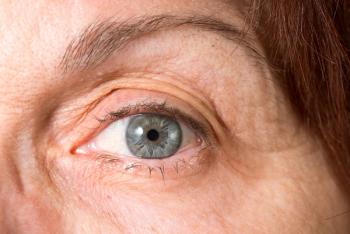
The hypothesis is based on a post hoc analysis of data from 2 phase 3 clinical trials of pegcetacoplan by Dun Jack Fu, PhD, and colleagues.


Stealth BioTherapeutics enrolls first patient in global Phase 3 clinical program for elamipretide in patients diagnosed with dry AMD

Data and Safety Monitoring Board approves simultaneous enrollment in Cohort 3 and Phase 2 initiation in OCU410 ArMaDa study for GA

The hypothesis is based on a post hoc analysis of data from 2 phase 3 clinical trials of pegcetacoplan by Dun Jack Fu, PhD, and colleagues.

Data can clear a path to trends and strategies to meet patients’ needs

The company reported that statistically significant data was found supporting ANX007’s ability to provide vision loss protection in patients with geographic atrophy.

Kamuvudine-8, also known as K8, is administered to the back of the eye via a sustained released intravitreal implant.

According to the company, a subretinal injection of ATSN-201 was well tolerated in all patients in the first cohort with extensive resolution of schisis observed in 2 patients. Safety data from the first cohort of the LIGHTHOUSE study will be presented at the Retinal Cell and Gene Therapy Innovation Summit 2024 being held May 3, 2024, in Seattle.

Researchers found the model demonstrated “near-perfect” detection capabilities.

According to the company, OCU410 utilizes an AAV delivery platform for the retinal delivery of the RORA gene.


Explore cutting-edge ophthalmology innovations in this new series on the Ophthalmology Times EyePod podcast. Throughout this series, we'll hear insights from various stakeholders in clinical practice, academia, and industry. In this episode, host Ehsan Sadri, MD, engages in a conversation with Jeffry Weinhuff, managing partner at Visionary Ventures, exploring trends and offering advice for individuals driven by an entrepreneurial mindset.

Since its U.S. launch in September 2023, more than 40,000 avacincaptad pegol intravitreal solution vials have been distributed to physician practices.

The Phase 2 trial tested whether inhibiting microglia with minocycline might help slow GA expansion and its corresponding vision loss.

OCU410 is a modifier gene therapy candidate being developed for geographic atrophy, an advanced stage of dry age related macular degeneration.

Early detection of the disease is key to optimal patient outcomes


Sydney M Crago, the editor of Modern Retina, talks with Arshad M Khanani, MD, MA, FASRS, about the expanded efficacy data from the GATHER 2 trial for geographic atrophy (GA).

Trial will analyze efficacy, safety of AVD-104 versus avacincaptad pegol to treat GA

The company’s ANX007 global pivotal program in geographic atrophy is expected to start in mid-2024. It is the first pivotal trial to use vision preservation as a primary outcome measure in GA.

Anchored matching-adjusted indirect comparison may aid decision-making

The drug is being evaluated on its safety, tolerability and pharmacokinetics of intravitreal single-rising doses and multiple doses as a potential treatment for GA.

Prevent Blindness is providing free geographic atrophy educational resources for patients, care partners and healthcare professionals, including a new episode of its Focus on Eye Health Expert series.

Mohammed Genead, MD, CEO of Aviceda spoke with the Ophthalmology Times team about the company's Phase II/III SIGLEC trial part 1 results, which were shared at this year's American Academy of Ophthalmology meeting.

Charles Wykoff, MD, PhD, spoke with Ophthalmology Times about the GALE study data at one year looking at pegcetacoplan for the management of geographic atrophy at this year's American Academy of Ophthalmology meeting.

Caroline Baumal, Chief Medical Officer at Apellis, spoke with Ophthalmology Times on the GALE extension study of pegcetacoplan for geographic atrophy, and shared insights on her career transition, emphasizing the significance of mentorship and a passion for one’s work at this year's American Academy of Ophthalmology meeting in San Francisco.

This retrospective, multicenter, observational study examined Japanese patients with GA to determine the clinical characteristics and GA progression rate associated with AMD in an Asian population.

Results showed that IZERVAY met the primary objective of reducing the rate of geographic atrophy (GA) growth in patients treated monthly compared to sham-treated patients